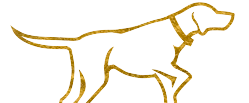Your Cart is Empty
{# PADRE SIN ENLACE #} Electronic Collars
{# PADRE SIN ENLACE #} Collars and Leads
{# PADRE SIN ENLACE #} Dog Tracking Systems
{# PADRE SIN ENLACE #} Dog Training
{# PADRE SIN ENLACE #} Bird Launchers
{# PADRE SIN ENLACE #} Hunting Dog Supplies
{# PADRE SIN ENLACE #} For The Hunter
Broken Dog Tail
January 18, 2016 3 min read
One of my favorite moments with my canine friends is when they greet me at the door with their tails wagging as if to welcome me home and tell me that I'm the most important person in their world. We really do like to think of tail wagging as a sign that our canine friends are happy to see us, but in reality, tail wagging is much more than a dog's way of saying hello, it's also a sign of our dog's health and emotional state.
Dogs use their tails to communicate their emotional state of happiness, fear, agitation, aggressiveness, and other emotions. Most often we associate a wagging tail with a happy friendly dog that wants to greet us, but that is not always the case and people often get bitten by tail-wagging dogs because we read the signs incorrectly. For help figuring out what the tail wag means to look for the direction of the wag or at how fast his tail is moving.
Research shows that dogs wag their tails to the right when they are happy and to the left when they are frightened. When a dog's tail is wagging back and forth in a high position the dog is likely happy. When the tail is between the dog's hind legs the dog is feeling frightened or submissive. When wagging the tail low the dog may be feeling insecure. Dogs usually wag their tails for other dogs, humans, and other animals.
Dogs also use their tails for balance while running and walking on narrow paths. Retrievers actually use their tails to steer through the water. And for some puppies chasing their tail provides a way to burn some extra energy.
So you can see that dog tails are meant for more than communicating body language that the dog is happy. The tail is an important part of the dog's anatomy. With it he communicates with his mother and littermates, and with it he communicates his emotional state to other dogs and humans, and he uses it to maintain his balance when running or walking on narrow trails and some dogs use their tail to steer through water.
Signs of a broken tail.
A broken tail can diminish your dog's mood and attitude, not to mention cause your dog severe pain. Your dog may have a broken tail if there is swelling or a bend or kink in the tail, and it will usually hang limp. Also, blood may be present if the tail was injured in some severe way such as getting hit by a car or getting bit by another animal.
An injured tail can be dangerous to the dog as well as painful, and breaks nearer the base of the tail can potentially cause nerve damage to the dog, and in cases of bleeding or punctures infection can set in. A broken tail is not easy to treat at home because if the tail is not reset properly it could result in a permanently kinked tail. If you suspect your dog has a broken tail you should make a trip to the vet, otherwise, you could be subjecting your dog to serious pain and great potential of infection, and a permanently damaged tail for your dog

This is what a broken tail can look like. It just looks curved sometimes not a sharp bend. It gets thicker in that area where the tail was broken. Don't delay and go to the vet. Get an X-ray and get antibiotics started if recommended. Without antibiotics, it can become infected and if delayed could result in having a portion of the tail cut off. My dogs had 3 broken tails over the years and I haven't had one fuse yet and repair itself but I'm told it can. Speer's tail shown here is after antibiotics and is good so far after 2 weeks rest.
There are cases of injured tails that appear broken but are actually a case of the limp tail syndrome often occurring in sporting dogs due to extreme physical activity. The limp tail will be sensitive and have a similar appearance as the broken tail, but the tail will often come back to full use in a few days.

Deuce had his tail cut off 6 years now but still looks pretty good to me.
Leave a comment
Comments will be approved before showing up.
Subscribe
Sign up to get the latest on sales, new releases and more …
Featured Products

Subscribe
Sign up to get the latest on sales, new releases and more …
Lion Country Supply — Trusted Hunting Dog Supply Store Since 1974 | Over 50 Years Serving Bird Dog Owners



